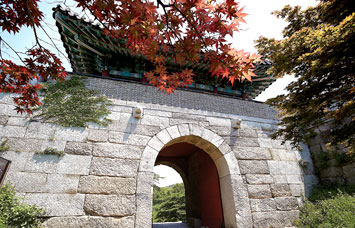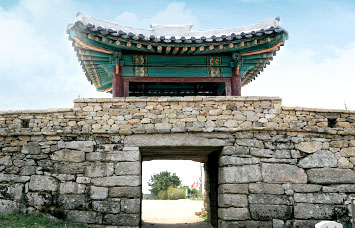
- Tourist Attraction
- Traditional Temples, Historic Sites
- Geumjeongsanseong Fortress
Geumjeongsanseong Fortress

Historic Site No. 215. It is the largest Korea’s fortress. Its fortress wall is18,845 meters long and 1.5-3 meters high with a gross area of approx. 8.2 square kilometers.

- Designation number of cultural heritage and designation date : Historic Site No. 215/ February 9th, 1971
- Scale : Length: 18,845 meters / Height : 1.5-3 meters / Total area of the inside fortress : Approx. 8.213 square kilometers
Tourist attractions
Geumjeongsanseong Fortress is composed of four gates and four watchtowers.
Guide to attractions
Click on each image, and you can see enlarged images with detailed descriptions.
- detail
 The First Watchtower
The First Watchtower
- detail
 The Second Watchtower
The Second Watchtower
- detail
 The Third Watchtower
The Third Watchtower
- detail
 The Fourth Watchtower
The Fourth Watchtower
- detail
 Command Post of Geumjeongsanseong Fortress
Command Post of Geumjeongsanseong Fortress
East Gateof Geumjeongsanseong
- Designation number of cultural heritage : Historic Site No. 215
- Location : San 41-2, Geumjeong-gu, Busan Metropolitan City

Located on the pass (415m) of the main ridge of Mt. Geumjeongsan, the East Gate commands outstanding landscape and is most accessible, so it is recognized as the best gateway to Geumjeongsanseong.
According to Stone Monument for Reconstruction of Geumjeongsanseong Fortress, “The construction of the East Gate was completed in one month after engineering works began in 1807 (7
th year of King Sunjo).” This gate is in
hongye (arch) style with a one-story gambrel-roofed gate tower. This open pavilion-style gate tower without walls extends three
kan (measurement unit corresponding to the space between two columns) on the front side and two on the side. The arch gate is 300 centimeters wide and 340 centimeters high.
There is a story about Dongnae Magistrate Jeong Hyeon-deok (1867-1874) who strived to restore the East and West gates.
After asking all around, he finally found two renowned masons to build perfect fortress gates. They were a master and his student. The magistrate ordered the master and his pupil to build the East and West gates, respectively. The master in charge of the East Gate was very ambitious and greedy, so he only tried to make the gate look majestic. On the other hand, his pupil was focused on the delicate aesthetics and applying high-level skills, so he built the gate more quickly than his master. Because the master was jealous of his pupil’s brilliant skills, the people at that time hated the master and praised the pupil’s techniques. However, it is said that they worked together to complete the construction of Yeongnamru in Miryang after building the East and West gates.

West Gate of Geumjeongsanseong
- Designation number of cultural heritage : Historic Site No. 215
- Location : 133, Geumseong-dong, Geumjeong-gu, Busan Metropolitan City

This is the only gate that is situated in the valley among the four gates of Geumjeongsanseong. The gate tower and its ㄷ-shaped fortress wall look impregnable and beautiful. This gate used to be crowded with people coming from and going to the Nakdonggang River, Gupo, and Gimhae.
This gate is in
hongye(arch) style with a one-story gambrel-roofed gate tower. This open pavilion-style gate tower without walls extends three
kan (measurement unit corresponding to the space between two columns) on the front side and two on the side. Jeokdae was restored on the right and left sides. It is a 4-meter wide and 5-meter high gate-guard platform. The floodgate of Daecheoncheon Stream north of the West Gate is an arch bridge style with three arched gates that are about 2.5 meters wide and 3 meters high. This is the only floodgate in Geumjeongsanseong Fortress, which shows our ancestors’ wisdom of building the West Gate and the floodgate in the valley, thus building upon a natural fortress.
There is a story about Dongnae Magistrate Jeong Hyeon-deok (1867-1874) who strived to restore the East and West gates.
After asking all around, he finally found two renowned masons to build perfect fortress gates. They were a master and his student. The magistrate ordered the master and his pupil to build the East and West gates, respectively. The master in charge of the East Gate was very ambitious and greedy, so he only tried to make the gate look majestic. On the other hand, his pupil was focused on the delicate aesthetics and applying high-level skills, so he built the gate more quickly than his master. Because the master was jealous of his pupil’s brilliant skills, the people at that time hated the master and praised the pupil’s techniques. However, it is said that they worked together to complete the construction of Yeongnamru in Miryang after building the East and West gates.

South Gate of Geumjeongsanseong
- Designation number of cultural heritage : Historic Site No. 215
- Location : San 69, Geumseong-dong, Geumjeong-gu, Busan Metropolitan City

Godangbong Peak is seen looking up to the north of the South Gate while Mt. Baekyangsan is viewed to the south of the gate. Mandeokgogae Hill and Mandeok-dong are situated between Mt. Baekyangsan and the South Gate. This is a square-shaped 2.8-meter high gate with a width of 2.90 meters. Its stone masonry wall is 4.8 meters wide. On top of the stone masonry wall sits a one-story, gambrel-roofed gate tower in
ikgong style (with bird-wing-shaped eaves). This open pavilion-style gate tower without walls extends three
kan (measurement unit corresponding to the space between two columns) on the front face and two on the sides. The battlement called
yeojang atop the wall has been restored since 2009, making the South Gate look more magnificent.

North Gate of Geumjeongsanseong
- Designation number of cultural heritage : Historic Site No. 215
- Location : San 1-1, Geumseong-dong, Geumjeong-gu, Busan Metropolitan City

This gate is located where the main ridge running southward from Godangbong 1.6 kilometers away from Beomeosa Temple rises up toward Wonhyobong Peak again.
Among the four gates of Geumjeongsanseong Fortress, the North Gate looks to be the toughest and most unsophisticated. There are no arched decorations and it is smaller than other fortress gates. On top of the stone masonry wall sits a one-story, gambrel-roofed gate tower in
ikgong style. This open pavilion-style gate tower without walls extends one
kan (measurement unit corresponding to the space between two columns) on the front face and one on the sides. The front and side widths of the rectangular gate are 2.5 meters and 3.5 meters.
A place around Sesimjeong Spring was where Great Master Wonhyo preached the Avatamska Sutra. So, it was called Hwaeombeol and it used to be a training field to train Buddhist monks from Beomeosa, Gukcheongsa, and Haewolsa and beyond for the purpose of defending Geumjeongsanseong Fortress.

The First Watchtower of Geumjeongsanseong Fortress

Located on top of Saenggibong Peak (650m) 300 meters away north of Sanggyebong Peak, the First Watchtower was restored as a gambrel-roofed structure.This open pavilion-style watchtower without walls extends one
kan (measurement unit corresponding to the space between two columns) on the front face and two on the sides. However, it was destroyed due to Typhoon Rusa. The extant remains of the building are stylobate, the foundation stone, and fences.

The Second Watchtower of GeumjeongsanseongFortress

Located on Dongjebong Peak (545m) approximately 2.5 kilometers away to the north of the East Gate and 400 meters away to the east of the East Gate, the Second Watchtower was restored as a gable-roofed watchtower. This open pavilion-style watchtower without walls extends two
kan (measurement unit corresponding to the space between two columns) on the front face and one on the sides.

The Third Watchtower of GeumjeongsanseongFortress

Located on a rock atop a steep cliff approximately one kilometer away from the East Gate, the Third Watchtower is a gable-roofed watchtower. This open pavilion-style watchtower without walls extends two
kan (measurement unit corresponding to the space between two columns) on the front face and one on the sides. It commands a gorgeous sillouhette standing in harmony with neighboring diverse, grotesque rocks such as Nabi-Bawi and Buchae-Bawi.

The Fourth Watchtower of GeumjeongsanseongFortress

The Fourth Watchtower is located on a ridge (620m) which joins with Jungseong and 1.5 kilometers away south of the North Gate. It was restored as a gable-roofed watchtower.This open pavilion-style watchtower without walls extends two
kan (measurement unit corresponding to the space between two columns) on the front face and one on the sides. This is one of triangulation points along with both the eastern wall of the southern outside fortress and the eastern extremity of Jungseong fortress to form atriangular zone.

Command Post of Geumjeongsanseong Fortress
- Designation number of cultural heritage : Historic Site No. 215
- Location : San 5-5, Geumseong-dong, Geumjeong-gu, Busan Metropolitan City

Command Post, built on the summit (475m) of a hillock at the center of Geumjeongsanseong Fortress, provides a full view of its entire expanse.
The open pavilion-style building without walls, designed to provide the best view onto the surroundings, extends three
kan (measurement unit corresponding to the space between two columns) on the front face and two on the sides, and is surmounted by a hipped gambrel roof.
According to Dongnaebuji, a Joseon-era book about the Dongnae region, the command post was built in 1703 (29
th year of King Sukjong), but the image of the command post building appears on maps in cartographical works such as Yeojido and Busan Gojido, suggesting that the original building existed at least until the late 19
th century.
This command post was restored on May 25
th, 2009, according to the findings of the historical investigation by the Cultural Heritage Committee.

Location
Based on the North Gate, walk a distance approximately 1.6 kilometers along the hiking trail up toward the North Gate from Beomeosa Temple. (Get off at Beomeosa Station of Metro Line 1 and take Shuttle Bus 90.)
Origin
There is no literature to cite when fortresses began to be built in Mt. Geumjeongsan, but, there is an idea that there might already have existed fortresses in Silla, considering severe Japanese invasions on the south coast and down the Nakdonggang River.
Along with the extant mountain fortresses, Dongnae Magistrates Park Tae-hang and Lee Ya were in charge of building this fortress in 1703 (29th year of Sukjong). The Magistrate of Dongnae Han Bae-ha was in charge of building Jungseong Fortress in 1707 (33rd year of Sukjong, and then Magistrate of Dongnae Oh-Han-won was in charge of restoring the destroyed building in 1808 (8th year of Sunjo).
It was designated as a Stated-designated historic site in 1971 and the two-year project began to restore its East, West, South, and North gates, which had been damaged during the Japanese rule of Korea. Since then, the restoration project has proceeded.

 The First Watchtower
The First Watchtower The Second Watchtower
The Second Watchtower The Third Watchtower
The Third Watchtower The Fourth Watchtower
The Fourth Watchtower Command Post of Geumjeongsanseong Fortress
Command Post of Geumjeongsanseong Fortress













